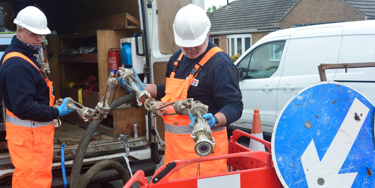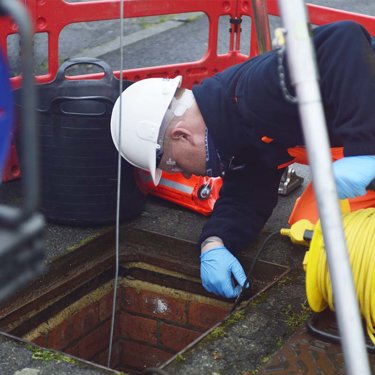Understanding trenchless cured-in-place pipe (CIPP) lining for drainage repair
27 March 2024
You have had a CCTV survey and it has identified a number of defects with your drainage. Trenchless cured-in-place pipe (CIPP) lining has been identified as a viable, cost-effective option, so what next? In this article we explain the process of cured-in-place pipe lining, the various considerations involved, and an overview of the different technologies.

The process
You have identified a problem on your site, such as blocked or backing up drains. Firstly, our experts will carry out a CCTV survey of your site’s drainage systems to identify the layout, condition, and capacity to cope with trade waste.
Any defects will be coded by a professional surveyor and a remediation report generated. The remediation report will identify the most effective and cost-efficient process for remediating your drainage. This could include trenchless, CIPP lining technology.
If cured-in-place pipe lining is proposed, a robotic cutter and jetter will firstly clear the pipe of any debris. The lining is then pulled into place within the host pipe and cut to length, and air is used to inflate the liner. The light train is then fed into the pipe and curing begins.
With the liner cured, the light train is removed and the ends are cut off, and a robotic cutter reopens any laterals. A further CCTV survey confirms that the work has been effective.
Considerations
Where cured-in-place pipe lining is selected, our experts will first consider the following factors:
- Geography – We will assess the physical layout and features of your site.
- Impact – Is there any likely disruption to homes, business, transport etc?
- Environment – Is the site protected in any way?
- Safety – Is the planned repair safe for the public?
- Access – Can plant and machinery reach the access points to the drain?
- Pipe characteristics – We will assess the pipes construction and material, severe angles or changes in shape and the extent and seriousness of any damage.
- Weather conditions – changes in temperature and moisture can influence the lining process and alter chemical reactions when mixing resins.
- Ecology – We may need to take into account the presence of protected species on site.
Trenchless technology options
UV Lining
UV light liner is primarily glass matting with some needle felt added as a wearing course, and UV receptive polyester or vinyl ester to cure. The sewer liner is impregnated with light-sensitive resin and a specialist UV light train is pulled back through the run to cure the resin. It can be used on pipes between 150mm and 1800mm but is restricted to straight runs. This is the fastest type of lining technology on the market.
LED light lining
LED lining works in the same way to UV lining, but uses an LED bulb rather than UV light to cure the liner. The smaller bulb means it can be used in smaller pipes and on bends up to 90°.
Ambient cure lining
Ambient liner is a needle felt tube impregnated with polyester resin. The resin-impregnated liner is installed using a compressor and an inversion drum and is cured by the external temperature. This method is slow and is ideal for managing existing flows. It can be done from one access point.
Hot cure lining
Hot cure liner is usually needle felt impregnated with either polyester, vinyl ester or epoxy resin. The felt may be strengthened by the addition of glass strands during the needling. The liner is inserted into the pipe and inverted through to the next manhole. The liner is filled with water, which is heated to around 85° and circulated for 4 hours until the liner is cured. Once cool, the liner is cut to release the water so that the liner can be trimmed, and any lateral connections cut.
Pressure pipe lining
We have two pressure pipe lining solutions. One is structural, the other is not and is reliant on the host pipe. Our pressure pipe lining is designed for use in highly pressurised pipelines carrying firewater or gas, such as rising mains. Unlike other liners, our solution is self-supporting and doesn’t require curing.
Solving your drainage challenges
A specialist drainage partner will be able to work with you to find the most effective and cost-efficient technology to solve your drainage problems.
Here to keep your drainage flowing freely
Our experts are available now to help you understand and improve the condition of your drainage.
Speak to our experts

